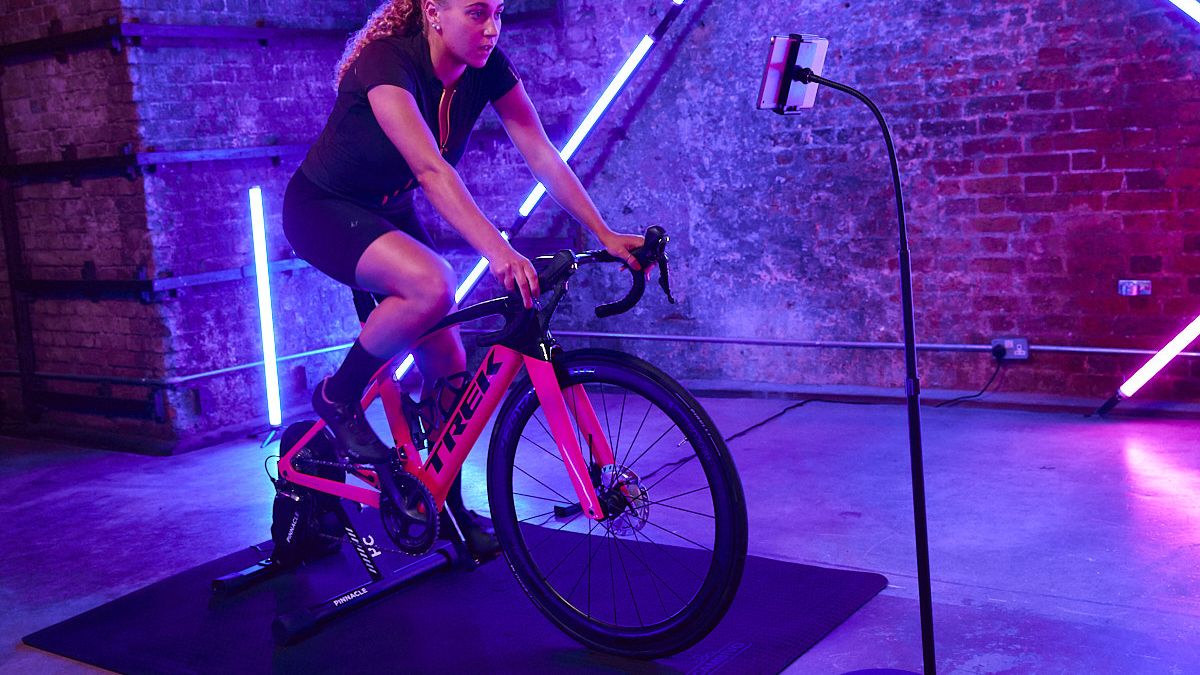

The best turbo trainers are incredibly versatile indoor cycling training tools. Sure, you can use rudimentary rollers for at-home training, but smart turbo trainers will enable you to actually enjoy cycling. Connect these trainers with virtual training tools, and you can practically recreate the outdoor cycling experience – indoors.
What is a turbo trainer? In simple terms, you mount the rear of your bike to a static unit – sometimes by the wheel itself, so the tyre sits on a roller, or by removing the wheel, so your chain runs on a cassette attached to the turbo. The result is an indoor exercise bike that rides like a real bike (sort of).
A turbo trainer is not only a great way to keep your fitness levels up in the colder and darker months, but it's also a very effective way to train when you've got limited time. Obviously, it also means you're entirely safe from traffic, bad weather, potholes and pedestrians. Indeed, many riders now use turbo trainers all year round because they are such practical training tools.
To clarify, you will need a bike and a turbo trainer, and if you haven't got one, we strongly encourage you to look at T3's best road bike and best triathlon bike guides to get started. We also have an indoor cycling guide, another article about the best Zwift setup for every budget and finally, the one where a cycling expert answers the 12 most Googled turbo trainer questions.
Best turbo trainers to buy right now
Why you can trust T3
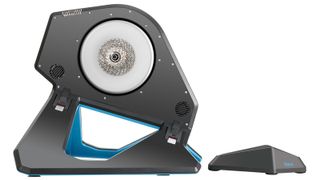

1. Tacx Neo 2 Smart
Specifications
Reasons to buy
Reasons to avoid
This is a case of evolution rather than revolution, but Tacx has made a few important upgrades to keep the Neo 2 on top of the pile. Most of the work has gone on beneath the Neo 2’s shell, with a more powerful chipset to further improve the realistic ride quality (and progressive resistance control) of what was already a super-smooth trainer. It’s quieter, too, with virtually the only noise being the gentle hum of your drivetrain.
The Neo 2 retains all the features that made us love the original, including the ability to simulate rough road surfaces on Zwift (gravel, cobbles etc.), and you get a little boost on virtual descents. ANT+ FE-C and Bluetooth Smart connectivity ensure the Neo can be hooked up to a range of third-party software, including Tacx’s own app. Finally, data fiends will be happy, with the Neo 2 capable of handling 2,200 watts (whether your legs are, is an entirely different story), with a claimed power accuracy of 1%.
On the flip side, the same sticking points as the original Neo apply here: this is a seriously heavy unit (21.5kg) and while the trainer folds up when in use, the large (and very stable) footprint takes up more floor space than most. There’s no doubt the Neo 2 is expensive too (yet doesn’t include a cassette), but that price tag is backed up by first-class performance.
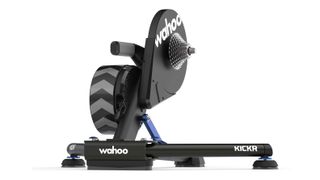

Specifications
Reasons to buy
Reasons to avoid
Wahoo only improved a few features and left others untouched: it might not make the new Wahoo KICKR appealing to people who own a V4, and, if anything, they might get annoyed that people who'll buy the V5 will get more for the same money they paid for their V4, but at the same time, they have probably been using their V4s for a number of years so really, everyone's a winner here, right?
This version of the KICKR was the most convenient turbo trainer from Wahoo to date when it was released. The fact that you don't need to perform a spin down, yet the trainer can maintain a +/-1% accuracy is just astounding. Not only will you save time, but you also wouldn't have to worry about the data collected not being precise.
The AXIS feet are a great new feature that will most likely please a lot of cyclists. Indoor cycling is getting more and more realistic, and the AXIS feet are a step in the right direction (pun intended). For the same price as the Wahoo KICKR V4, the new KICKR is an excellent buy and is highly recommended for serious cyclists.
Read our full Wahoo KICKR V5 review
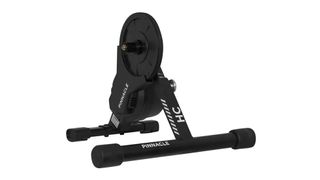

Specifications
Reasons to buy
Reasons to avoid
For the price, the Pinnacle HC Turbo Home Trainer is an excellent way to enter the smart trainer market. Setup is easy; it syncs to training software seamlessly, it’s super-quiet and provides resistance up to 20% elevation. All this combines to provide an indoor turbo trainer that will suit all your training needs for all but the most serious of cyclists.
Read our full Pinnacle HC Turbo Home Trainer review
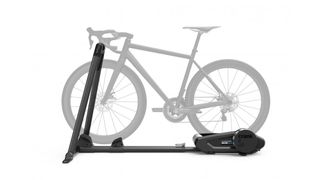

Specifications
Reasons to buy
Reasons to avoid
The Kickr Rollr nails some fundamentals: it’s easy to put together, straightforward to use and a dream for multi-rider households or those who hate the faff of putting a bike on and off a traditional smart trainer. The riding is smooth, and stability isn’t an issue either. That said, we felt less confident during out-of-the-saddle sprints during testing. The front wheel takes the full brunt of sprints, seeing as it’s the only fixed point on the trainer.
If you already have a power metre, then the Wahoo Kickr Rollr presents a compelling option as an alternative to a direct drive trainer. As a product, the Wahoo Kickr Rollr does what it advertises very well and can be a savvy option for multi-bike or multi-rider households.
Read our full Wahoo Kickr Rollr review
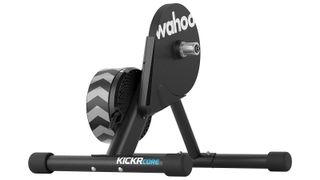

5. Wahoo KICKR CORE
Specifications
Reasons to buy
Reasons to avoid
Wahoo’s flagship Kickr is virtually neck-and-neck with the Tacx Neo 2 as a pro-level smart trainer - it’s used by Team Sky, after all - so why has the mid-range Kickr Core wrestled the number two spot from its more expensive sibling in the Wahoo range? One word: price. The Kickr Core, unlike the high-end Kickr and cheap Kickr Snap, is aimed at the crucial midmarket slot.
The Kickr Core is a direct-drive unit, so you get the realistic ride quality you’d expect from a smart trainer like this. That’s helped by the 18kg flywheel, capable of replicating 1,800 watts and a gradient of up to 16 per cent, although naturally, those figures aren’t as impressive as the flagship Kickr (21kg, 2,200 watts and 20 per cent, respectively).
The Kickr Core is compatible with Wahoo’s Kickr Climb gradient simulator - attach your bike’s fork to the Climb, and it will rise and fall with the changing gradient when using software like Zwift. If you want the very best money can buy, the Tacx Neo 2 is our recommended smart trainer, but if you’ve got a more realistic budget - and still want most of the top-end performance - the Wahoo Kickr Core is our go-to option.
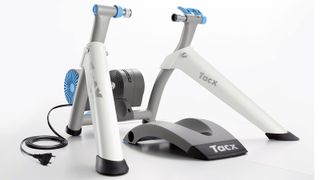

6. Tacx Vortex Smart
Specifications
Reasons to buy
Reasons to avoid
Want the smart trainer experience at a wallet-friendly price? The Tacx Vortex Smart is, well, a smart option. At first glance, it looks like a typical wheel-on turbo, but plug the Vortex into the mains and you’ve got a fully-fledged smart trainer, ready to be hooked up to just about any software you like.
It might be a budget option but the Vortex Smart is still capable of automatically controlling resistance, so as the gradient steepens in Zwift or you hit the next interval in the Tacx app, the trainer will ramp up the effort required to keep the pedals turning. That said, there’s a much tighter limit as to what the 1.6kg flywheel (with an effective resistance of 11.8kg) can handle, with a maximum power output of 950 watts and a maximum incline of seven per cent.
One benefit of a traditional setup like this is that it’s nice and compact when folded down and takes little time to drop your bike into place (although, unlike a direct-drive trainer, the wheel-on design may wear down your rear tyre).
Of course, you don’t get the power accuracy or realistic ride quality of a more expensive smart trainer, nor the ability to handle Cavendish-like sprints, but the Tacx Vortex Smart offers a significantly cheaper route into the latest virtual training software.
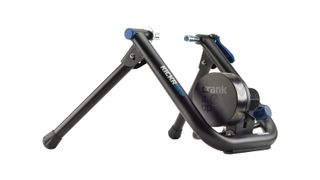

Specifications
Reasons to buy
Reasons to avoid
You have to love the Wahoo Kickr Snap Bike Trainer. It takes the hassle out of indoor cycling training and makes good use of the road bike you've already got. Unlike indoor exercise bikes, it takes up very little space (when the bike is not mounted on it), just fold it up and store it under the bed.
Setting up the Wahoo Kickr Snap Bike Trainer is dead simple: unfold, mount the bike, plug it in, pair it with a phone/tablet and you can start cycling straight away. The whole process takes less than 15 minutes the first time and even less after the initial setup.
The Wahoo Kickr Snap Bike Trainer is also well-connected to third-party apps: let it be Zwift, Sufferfest or TrainerRoad, you will find an app you can use to structure your indoor training sessions effectively (a full list of apps can be found here - links to Wahoo's site)
The Wahoo Kickr Snap Bike Trainer is a versatile and reasonable indoor smart trainer that provides a lot of features, superb build quality and a great cycling experience for cyclists of all abilities.
Read our full Wahoo Kickr Snap Bike Trainer review
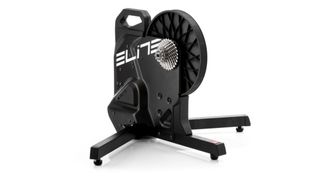

Specifications
Reasons to buy
Reasons to avoid
The Elite Suito is ideal for anyone who likes to use apps and data to maximise their bike time, who doesn’t have a lot of space, who prefers a quieter trainer and who likes the more natural ride feel of a direct-drive machine.
The setup is extremely easy, and everything seems to work as advertised, including the ‘plug and play’ element. In fact, this would have scored a perfect 5 stars, if it weren’t for the fact it no longer comes with a cassette. Having one installed adds a significant layer of effort that's all the more frustrating because it used to just come as part of the package.
However, once you've got out your toolbox, watched a few YouTube tutorials and got your cassette in place, the Elite Suito is a pleasure to use and ride and a bargain at its price. Highly recommended, then.
Read our full Elite Suito review


Specifications
Reasons to buy
Reasons to avoid
Considered on its own, the Tacx Boost is an okay budget, a no-frills trainer with a few faults that nevertheless does a reasonable job. It’s simple to set up, doesn’t require power, and is relatively low priced. On the flip side, it’s pretty loud, a bit unstable, and doesn’t offer much in the way of metrics.
However, where it really falls down is that there are other trainers on the market at a similar price – or only slightly more – that offer considerably more in terms of design, stability and features. So really, unless you want the absolute entry-level, it's overall quite hard to recommend the Tacx Boost.
Read our full Tacx Boost review
How to buy the best turbo trainer for you
The Tacx Neo 2 and Wahoo Kickr are two of the most sophisticated turbo trainers on the market. Both are 'direct-drive trainers, meaning you mount your bike directly on the turbo by removing the back wheel – your chain then runs on a cassette attached to the trainer, completing the drivetrain. They are also 'smart trainers' because they offer built-in connectivity and can be used with third-party apps like Zwift, TrainerRoad and the Sufferfest on your phone, tablet or laptop. It’s this connectivity that’s revolutionised indoor training.
Smart trainers use an app to automatically control the resistance on your trainer - for example, to simulate climbing uphill or if you start an interval in a structured training session. The two-way communication between the app and the trainer works through ANT+ or Bluetooth and makes the indoor training session more like an outdoor ride. Direct-drive turbo trainers offer a significantly smoother and more realistic ride experience than traditional magnetic or fluid trainers.
Your rear tyre sits on a small roller in the trainer, which sets the required resistance - either automatically in the case of a smart trainer or via a handlebar-mounted adjustable lever on cheaper, old-school trainers. ‘Wheel-on’ trainers like this offer a less realistic ride experience, are noisier and can wear your back tyre, but you may consider that a price worth paying to save money.
Finally, if you’re looking for an entry-level trainer, there are even cheaper solutions going all the way down to the cheapest models. These turbo trainers might not be ‘smart’, but they aren't dumb either if you're on a budget or simply want an indoor trainer to keep the pedals turning through winter.
FAQ
What is the best turbo trainer?
The Tacx Neo 2 Smart currently tops our round-up of the best turbo trainers, but there’s not much to separate the Neo 2 and the equally excellent Wahoo KICKR. Both offer stunning (and near-silent) performance, but for us, Tacx’s flagship design has the edge and justifies its higher price.
Why the Neo 2? It boasts the most impressive numbers on paper, and the virtual flywheel offers an extremely realistic ride quality. It doesn’t need calibration, many of the features can be used without a power source, and while the physical footprint of the unit is big, it’s extremely stable when sprinting out of the saddle. The key updates to the Neo 2 over the original Neo are internal, with the trainer’s electronics getting revamped, and that’s prepared the unit for a slew of new (and future) software features.
The Neo 2 can simulate road conditions such as cobblestones, dirt roads and even gravel sets it apart from rivals. What’s more, the spaceship design is straight from Star Wars, with a fluoro light show on the ground that changes according to your training effort, from easy blue to full-throttle red.
The updated Wahoo Kickr is well worth a mention here, though. It’s a fantastic smart trainer and sneaks in under a grand. Despite that, we’ve actually included the Kickr Core as our pick from Wahoo’s range – if you want the full smart trainer experience but don’t want to pay top dollar, this is T3’s pick.
What turbo trainer do pros use?
Pro cyclists tend to use turbo trainers from brands they are affiliated with. For example, INEOS and Bora Hansgrohe cyclists used Wahoo KICKR turbos for their Tour de France 2021 training.
Sign up to the T3 newsletter for smarter living straight to your inbox
Get all the latest news, reviews, deals and buying guides on gorgeous tech, home and active products from the T3 experts

Matt Kollat is a journalist and content creator who works for T3.com and its magazine counterpart as an Active Editor. His areas of expertise include wearables, drones, fitness equipment, nutrition and outdoor gear. He joined T3 in 2019. His byline appears in several publications, including Techradar and Fit&Well, and more. Matt also collaborated with other content creators (e.g. Garage Gym Reviews) and judged many awards, such as the European Specialist Sports Nutrition Alliance's ESSNawards. When he isn't working out, running or cycling, you'll find him roaming the countryside and trying out new podcasting and content creation equipment.
-
 Best YETI coolers 2025: ice cold excellence
Best YETI coolers 2025: ice cold excellenceKeep food and beverage frosty with our curated selection of top-rated YETI coolers for every occasion
By Matt Kollat Last updated
-
 Best cool box for camping 2025: keep your food and drinks cool and fresh
Best cool box for camping 2025: keep your food and drinks cool and freshBrowse the best cool boxes, cool bags and electric coolers for camping, festivals, picnics and balmy days at the beach
By Matt Kollat Last updated
-
 Best pressure washer 2025: clean everything from patios and decking to cars and mountain bikes
Best pressure washer 2025: clean everything from patios and decking to cars and mountain bikesGet brilliant results and save a lot of elbow grease with the best pressure washers on the market
By Lizzie Wilmot Last updated
-
 Best smart ring 2025: compact, lightweight health-tracking wearables
Best smart ring 2025: compact, lightweight health-tracking wearablesExperience wearable innovation at your fingertips with the best smart rings available now
By Matt Kollat Last updated
-
 Best cold weather gloves 2025 for toasty fingers in any conditions
Best cold weather gloves 2025 for toasty fingers in any conditionsThese are the best cold weather gloves for outdoor winter adventures without running the risk of frostbite
By Dave Stevenson Last updated
-
 5 fans you can use outside: take the heat off with practical outdoor-friendly blowers
5 fans you can use outside: take the heat off with practical outdoor-friendly blowersThe best fans for outdoor use at home and away to tackle the summer heat
By Derek Adams Last updated
-
 Best Christmas gifts for yoga fans: ideas for beginners to experts
Best Christmas gifts for yoga fans: ideas for beginners to expertsKnow someone who loves yoga? Here are the best Christmas gift ideas for yogis
By Bethan Girdler-Maslen Published
-
 Best gifts for golfers 2025: present ideas to up their game
Best gifts for golfers 2025: present ideas to up their gameOur selection of the best gifts and presents for golfers includes clothing, watches and 'interesting' aids to swing improvement
By David Usher Last updated

